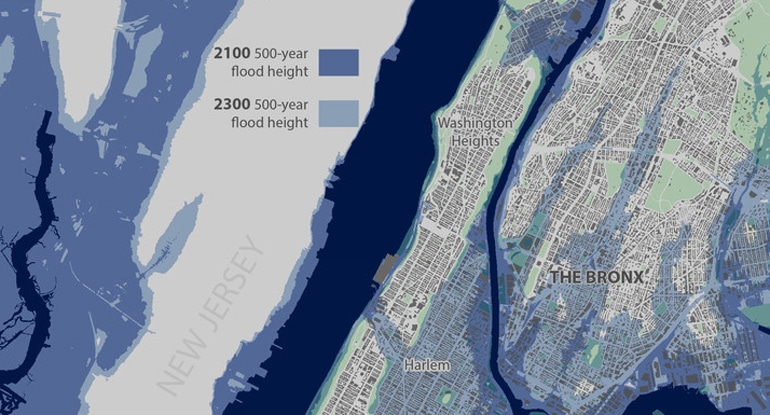A warming climate that causes rising sea levels could lead to greater future storm damage to New York City, new research suggests.
The research also finds, however, that the paths of stronger future storms may shift offshore, changing the coastal risk for the city.
“Sea level is rising and higher sea level increases the damages from coastal storms…”
“If we cause large sea-level rise, that dominates future risks, but if we could prevent sea-level rise and just have the storm surge to worry about, our projections show little change in coastal risk from today during most years,” says Michael E. Mann, a professor of meteorology and atmospheric science and director of Penn State’s Earth System Science Center.
“While those storms that strike New York City might be bigger and stronger, there may be fewer of them as changing storm tracks increasingly steer the storms away from NYC and toward other regions,” Mann says.
Coastal damage increases if the sea level is higher before a storm, and if the extra surge caused by the storm is higher.
The researchers looked at the history and future of both sea level and storm surge, from preindustrial times through 2300, in models that had been run for the full period. They focused on results from simulations with rapid carbon dioxide release, often referred to as “business-as-usual” simulations.

Future changes in sea level and storms would be smaller if countries around the world took actions to slow climate change, such as the Paris Accord’s goal of limiting warming to 3.6 degrees Fahrenheit.
Sea level has been rising, and this is expected to continue as warming causes ocean water to expand and ice on land to melt, releasing water into the ocean. Rapid change in the behavior of parts of the Antarctic ice sheet might cause much greater rise than is often included in coastal planning.
The researchers first calibrated their sea-level models to simulate the rates of historic sea-level rise. Then they ran simulations for the future, with and without results of a recent study that projects large future Antarctic ice sheet melt with business-as-usual increases in levels of greenhouse gases. Such large Antarctic melt implies large increases in sea level, globally and at New York City.
What climate change means for northern, colder cities
If this Antarctic instability occurs, the future risk to New York City is dominated by sea level rise. Then, according to Andra J. Gardner, a postdoctoral fellow at Rutgers University, by 2100 the estimated 500-year flood height would be 17 feet, and by 2300 the 500-year flood height would be about 50 feet.
“Human decisions about energy will be important in determining how much the sea rises…”
A 500-year flood is one that has a 1 in 500 chance of occurring in any given year. Reducing warming enough to preserve the Antarctic ice would greatly reduce risk to New York City.
If sea-level rise remains small, then changes in storm surge are the most important concern for future coastal risk to New York City. In agreement with previous work, the models show that warmer future conditions allow stronger storms. But the models also show that the warming causes storm tracks to shift offshore and northward, away from New York City.
“If a shift occurs toward less common but possibly larger storms, it poses special challenges for coastal planners, and highlights the value of additional progress in understanding and projecting the tracks as well as the strength of these storms,” says Mann.
The paper describes the general agreement among the models studied that storms will strengthen and shift offshore with warming, but identifies important differences that could be reduced with further research.
“Sea level is rising and higher sea level increases the damages from coastal storms,” says Richard B. Alley, a professor of geosciences at Penn State. “Human decisions about energy will be important in determining how much the sea rises and thus how much damage we face, and accurate projections of storms will help in minimizing the risks.”
East Coast ‘hot spots’ speed up sea level rise
The researchers reported their results in the Proceedings of the National Academy of Sciences.
Additional researchers working on this project are from Penn State, Rutgers University, Massachusetts Institute of Technology, Princeton University, University of Massachusetts, and the Woods Hole Oceanographic Institute.
The National Oceanic and Atmospheric Administration, the National Science Foundation, Community Foundation of New Jersey, and David and Arleen McGlade supported this work.
Source: Penn State



